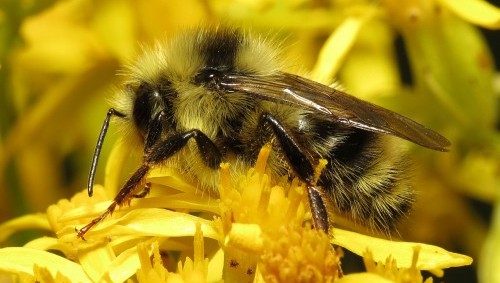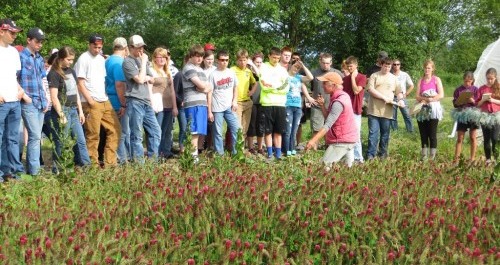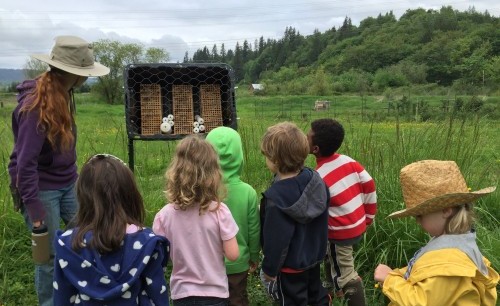Give native bees a chance
The world is–ahem–abuzz with news about honey bees. Colony Collapse Disorder, a mysterious bee die-off that first emerged in 2006, has only grown more serious and more perplexing under the scrutiny of research. The New York Times recently reported on a survey last year released by the Bee Informed Partnership: About 5,000 beekepers reported colony loss of 42 percent between April 2014 and April 2015, much higher than the once-normal expected loss of 10% and higher even than the 34.2 percent loss during the same period in 2013 and 2014.
Now, this is undeniably bad news. Bees are critically important to agriculture and their die-off (like ANY large-scale die-off) is a pretty reliable indicator that something is not going as it should. But the news is not all bad. Honey bees are not our only means of pollinating. Our backyards and undeveloped spaces hold at least the POTENTIAL to support resilient populations of hardy, industrious pollinators. This potential is recognized and made useful to different extents by different communities depending on predominating land management values.
You’re Worrying About the Wrong Bees is the title of an article that recently appeared in WIRED magazine highlighting the lack of media attention paid to our most important and most fragile bees: The almost 4,000 native species that have evolved to thrive alongside North American plants. Honey bees, with their support teams of researchers and beekeepers, are in no danger of extinction. Native bees, in much of the country, are. Ground-nesting bumblebees are devastated by clear-cutting, whether by timber industries or suburban developers, and diverse native plant life for native bee forage is becoming scarce as more acreage turns to mono-cropped corn and soy production.

A native bumblebee
Bees’ importance to agriculture cannot be understated, and the recent problem is so worrisome that the Obama administration just proposed a “National Strategy to Promote the Health of Honey Bees and Other Pollinators. That the president believes bees need a national strategy to save them is telling of the seriousness of the situation. While the bee problem IS national in scope, like ALL issues of environmental health, its manifestations are diverse and localized and call for diverse and localized solutions.
So what does a land management strategy that supports native bees look like? At Oxbow, it looks intentional and manifests in every aspect of our programming.
As a farm, we are acutely aware of the critical function that pollinators play in our ecosystem. Everything on our farm that fruits–all of the pears, apples, and plums in the orchard, the squash in the three sisters, the tomatoes and peppers in the hoop houses, the strawberries now ripe for the eating and the raspberries not far behind them–has an insect to thank for its transition from flower into food. We welcome (even lure) bees into our fields with rows of flowering clover, avoid pesticides that some experts are linking to bee collapse, and are in the process of installing hedgerows in the production fields stocked with native plants as a permanent bank of food.

Farmer Sarah sharing information about a field of crimson clover, a cover crop that doubles as native pollinator food, with a group of students
As managers of the landscape, we are involved in an ongoing, multi-year project to restore our wetland, riverbank, and hedgerows with native species, encouraging biodiversity, building habitat, and discouraging monopolization of resources by invasive plants and insects. Bridget and her team are working in the Native Plant Nursery to grow and encourage the incorporation of native plants in restoration and landscaping projects in our valley and beyond. One of this year’s Oxbow Fellows from the University of Idaho is even studying the propagation of milkweed to support monarch butterfly populations, another important pollinator.
As educators, we help tune kids’ perceptions of bees away from their learned fearfulness and towards an appreciation of bees’ role in our complex organic system. This year, our spring field trip visitors stopped on their farm tours at our bee blocks (or “bee hotels”) to observe native bees carefully constructing their nests. Mason bees, with their fuzz, non-traditional coloration, and preference for solitary life, are surprising enough to turn kids’ understandings of bees completely upside-down. “Those are BEES?” was the common, incredulous question.

Farmer Lauren shows a group of preschoolers from Stroum JCC our native mason bee boxes next to the orchard. Credit: Emily Schankerman
By nature, small-scale agriculture is generally friendlier to native bee populations than large-scale agriculture, and so supporting small farmers can be a proactive step for those wanting to lend bees a hand. We thank our CSA members for their special, season-long investment in supporting our brand of farming, our summer campers for helping us make meaningful connections with kids, and all of the landscapers, restoration professionals, and community members like YOU planting our native species and feeding bees all around the Puget Sound.
Together, many small efforts can add up to many big changes. All WE are saying is give natives bees a chance.
This article appeared in our newsletter June 15. Sign up.
Want more Ox? Follow us on Facebook, Twitter, or Instagram or subscribe to our newsletter.
